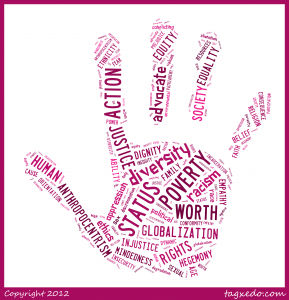Social Justice 12
Lesson Topic: Introduction to Discrimination and the BC Human Rights Code
Lesson Objectives 
- Construct a definition of the concept of discrimination based on current understanding.
- Compare personal understanding of the concept of discrimination by comparing definition to peers and the legal definition contained in the BC Human Rights Code
- *(A2) demonstrate effective research skills, including accessing information, assessing information and organizing and presenting data
- *(B3/ B4) describe and analyze specific examples of social injustice in Canada related to such characteristics as: age, marital or family status, mental or physical disability, political belief, race and ethnicity, religion and faith, sex, sexual orientation, socioeconomic status
- *(B5)analyse the roles played by legislation, the courts, public policy, and other forms of government action in promoting or failing to promote social justice in Canada.
*indicates related curriculum objectives/prescribed learning outcome for Social Justice 12 Integrated Resource Package 2008. Retrieved from: http://www.bced.gov.bc.ca/irp/pdfs/social_studies/2008socialjustice12.pdf
Step 1: What is discrimination?
- Without consulting any outside sources, construct a definition of discrimination and include specific examples to illustrate your example. Your definition should not exceed 100 words, so keep it clear and concise.
- Post your definition to the “Discrimination Wiki” in Moodle.
Step 2: Compare and revise your understanding.
- Read the legal definition of discrimination of the BC Human Rights Code provided by the BC Ministry of Attorney General http://www.ag.gov.bc.ca/human-rights-protection/pdfs/ProtectDiscrimination.pdf
- Compare your personal definition of discrimination to the definitions of your classmates to the legal definition posted above in the “Discrimination Wiki”. If you wish, you may use the comment feature in the wiki to give feedback to your classmates.
- Revise your definition on the wiki if you wish.
- Comment briefly below your definition as to why and how you chose to revise it or why you decided to leave it as is.
Step 3: Recognize and analyze.
- Find an online video, news article or describe a personal story which contains an example of discrimination in BC.
- Post the video / article/story in the “Discrimination Forum” along with a brief analysis which answers the following questions. Don’t forget to properly cite the source of your video/article.
- Give a brief summary of the events described in the video/article/story and identify the basis of discrimination demonstrated (age, sex, race, marital status, etc.).
- Is this type of discrimination prohibited (considered illegal) under the BC Human Rights Code?
- If it is, cite the specific section of the BC Human Rights Code.
- If it isn’t, explain why you think this is so.
- Was there a remedy (solution/resolution) to this example/case? For simple explanations and examples of remedies under the BC Human Rights Code, see the BC Human Rights Coalition website.
- If so, did you think it was appropriate? Why or Why not?
- If not, what remedy would you recommend? Why?
3. Read and respond to the posts, analyses and comments of others in the “Discrimination Forum”.
Step 4: Reflect
- In your course blog, reflect on and self-assess:
- your understanding of the concept of discrimination and its relationship to Social Justice;
- has your understanding changed from the beginning to the end of the lesson?
- your understanding and opinions of the BC Human Rights Code and how the BC government uses such legislation to deal with discrimination in our society;
- has your understanding changed from the beginning to the end of the lesson?
- your ability to achieve the objectives of this lesson.